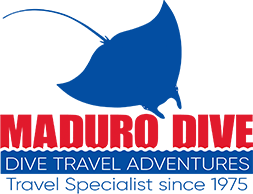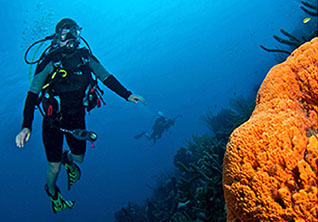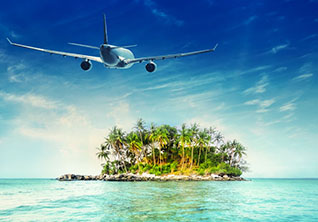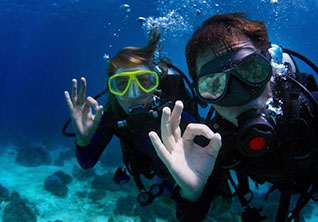Still got room in your passport book for an island nestled in the warm turquoise waters of the Caribbean? If not you better start adding pages because our new destination is soon to house 240 dive sites that are sure to leave even our most experienced readers in awe.
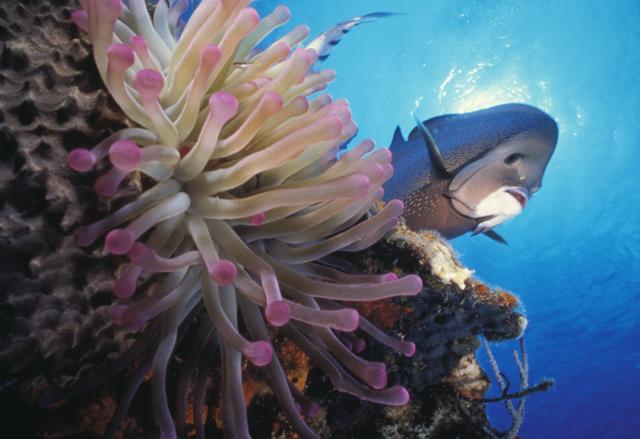
The Cayman Islands were discovered by European explorers. In 1503 Christopher Columbus sighted Cayman Brac and Little Cayman and named them Las Tortugas after the numerous sea turtles swimming in the surrounding waters. The 1523 Turin map referred to them as Los Lagartos, meaning alligators. By 1530 they were known as the Caymanes after the Carib word Caiman for the marine crocodile that lived there. Archaeological studies of Grand Cayman show no human occupation before the 16th century. The first recorded English visitor was Sir Francis Drake in 1586 and the year 1734 marks the first permanent settlement. A variety of people settled on the island but the majority are English and African descent.
Present day Grand Cayman has evolved into a major tourism and offshore banking center. The endless sandy beaches, upscale condos, resorts and attractions will please every visitor. But while there are many topside attractions, it is what lies underwater that lures scuba divers to Grand Cayman.
Diving Grand Cayman
Two of Grand Cayman’s most noted features for divers is its shore diving and numerous variety (did we mention 240) of exciting dive sites.Waters that average a warm 80 degrees year round, dramatic walls adorned with colorful corals, invertebrates and sponges, shallow reefs of fish (great for snorkelers), renowned wrecks, turtles, sharks, silversides, octopus, groupers, tarpon, spotted Eagle and Southern rays and more. Grand Cayman is also known for it’s amazing visibility (perfect for snapping endless underwater images), which usually exceeds 100 feet. But if this still doesn’t perk your fins then maybe the home of the world’s best 12-foot dive and legendary Stingray City and USS Kittiwake might spark your interest.
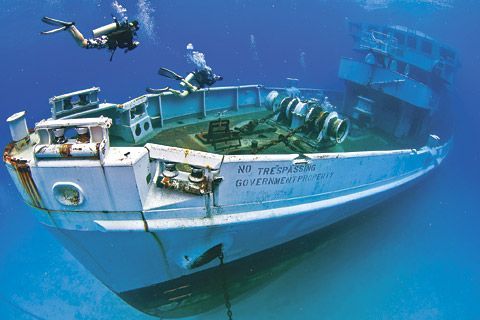
USS Kittiwake:
A 251-foot long decommissioned US Navy Rescue Ship rests 64 feet deep at the bottom of the ocean but is only 15 feet from the surface which is great for snorkelers and divers alike. This is one of the only places where snorkelers can enjoy a dive site and experience whatdivers see under the surface. Great attraction for non-diving family members and spouses!
Stingray City:
Another unique and world-famous dive! Stingray City is the only dive in the world where divers can interact with Southern Stingray. Once at the dive site you’ll be briefed on the do’s and don’ts and how to interact with the fish and stingray, then you’ll have 45 minutes to an hour with the marine life. Definitely a must-do dive!
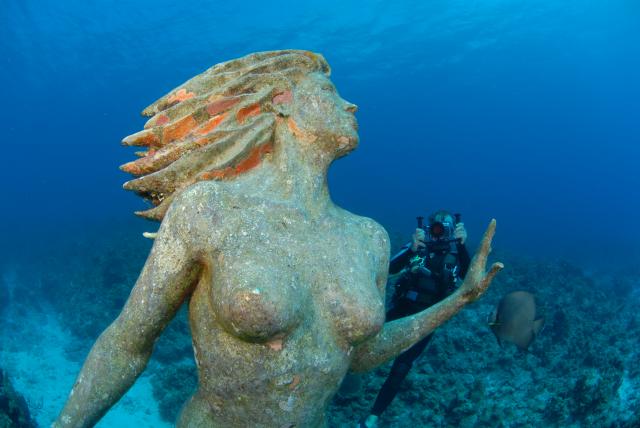
Amphitrite:
She’s one of the world’s most famous mermaids next to Ariel, and you’ve seen her online and in magazines from Scuba Diving Magazine to Sport Diver Magazine. This magnificent 9-foot tall bronze sculpture came from Canadian artist Simon Morris and was carefully placed underwater to keep a watchful eye over the beautiful reef.
The David Nicholson Wreck:
An old cargo ship now covered and surrounded by sea life makes for a great day or night dive. Deliberately placed to attract fish and marine life in the 80’s, the wreck is now teeming with colorful fish, sea turtles, nurse sharks, stingrays and more. There are plenty of other great dive sites (after all, there are 240!) including: Black Forrest, Eagle Ray Pass. Blue Pinnacles, Tarpon Alley, Trinity Caves, Andres Wall, the exhilarating North Wall and countless more.
Topside
You’ve gotta spend some time ashore and Grand Cayman’s got some great topside attractions to fill up your time when you’re not in your fins and wet suit.
So, what’s there to do on a 22-mile long island? TONS.
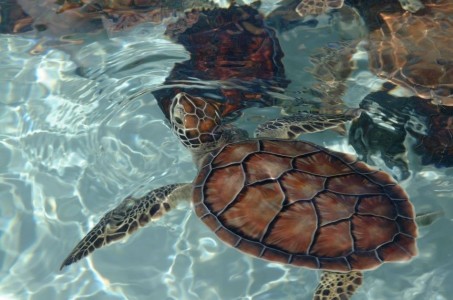
Cayman Turtle Farm:
We had to include a little sea life in our topside excursions… it just wouldn’t be right without it! This is a great attraction. This park allows visitors to learn about sea turtles, sharks and eels, birds, and other creatures. The park even allows observing and interacting opportunities with flora and fauna. Take a dip in their fresh water tidal lagoon, wander through their aviary and even swim and snorkel with fish and other marine life in a 1.3 million gallon salt water lagoon. (This is great for non-divers with an interest in the ocean).
Queen Elizabeth II Botanic Park:
Here you can get a real feel for Grand Cayman. Enjoy a lush garden popping with colorful flowers and vegetation, a turn of the century Cayman farm house complete with its original furnishings, and a two-acre lake home to native aquatic birds. This makes for a beautiful stop on your trip to Grand Cayman.
After a long day of dives and topside excursions chill out at the ocean’s edge. This is a great spot to enjoy the sunset while sipping on your after diving adult beverage. Oh and you don’t want to miss out on the Green Flash! It DOES exists and if you don’t believe us, experience it for yourself.
You can also visit Hell, a group of short black limestone formations, Pedro St. James National Historic Site, the antique car museum and Black Pearl Skate and Surf Park.
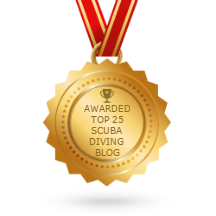
Recent Posts
- Eastern Malaysia, Sabah, Sipadan & More
- Ghost Pipefish, Pipefish, Seahorses, and Sea Dragons
- Australia Queensland and the Great Barrier Reef
- Tioman Islands, Malaysia
- The Riviera Maya
- The Peter Diving System
- The Bay Islands, Roatan, Utila, Guanaja, and more.
- The Cuttlefish; The Undisputed Master of Camouflage.
- The Maldives: A Garland of Islands in the Indian Ocean
- Frogfish, The Overlooked Camouflage Artist
Categories
- Australia
- Bahamas
- Bay Islands
- Belize
- Blue Hole
- Bonaire Diving
- Borneo
- Cayman Brac
- Cayman Islands
- Cozumel
- Curacao
- Cuttlefish
- Dive Destinations
- Dive Equipment
- Dive Liveaboards
- Dive Resorts / Properties
- Dive Travel
- Dive Travel Deals
- Diver Wellness
- Dolphins
- Dominica
- eagle rays
- Eagle Rays
- Family Travel
- Fiji
- Galapagos Islands
- Great White Shark cage diving
- Guanaja
- Honduras
- Indonesia
- Infographics
- Isla Mujeres
- Learning to Dive
- Little Cayman
- Maduro Dive Newsletter
- Malaysia
- Maldives
- Manta Rays
- Marine Life
- Mexico
- Micronesia
- Muck Diving
- Myamar
- Palau
- Papua New Guinea
- Pelagics
- Philippines
- Pinnacles
- Polynesia
- Reefs
- Riviera Maya
- Roatan
- Saba
- Sabah
- Scuba Diving
- Scuba Gear Reviews
- Scuba News/Events
- Scuba Training & Education
- Sea Legends
- sea lions
- Sea of Cortez
- Sharks
- Single Travel
- Sipadan
- Socorro Islands
- South Africa
- Specialties
- ST. Kitts
- Stingrays
- Tahiti
- Thailand
- The Bucket List
- Tobago
- Truk Lagoon (Chuuk)
- Turks and Caicos Islands
- Turtles
- Uncategorized
- Underwater Photography
- Underwater Video
- Utila
- Walls
- Whale Sharks
- Whales
- Wreck Diving
- Wrecks
- Yap
Archives
- January 2024
- April 2023
- March 2020
- March 2019
- January 2019
- November 2018
- September 2018
- July 2018
- May 2018
- March 2018
- January 2018
- October 2017
- September 2017
- June 2017
- April 2017
- February 2017
- January 2017
- October 2016
- August 2016
- July 2016
- May 2016
- March 2016
- February 2016
- January 2016
- December 2015
- August 2015
- June 2015
- April 2015
- January 2015
- November 2014
- July 2014
- April 2014
- February 2014
- December 2013
- November 2013
- October 2013
- September 2013
- August 2013
- July 2013
- June 2013
- May 2013
- April 2013
- March 2013
- February 2013
- January 2013
- December 2012
- November 2012
- October 2012
- September 2012
- August 2012
- July 2012
- June 2012
- May 2012
- April 2012
